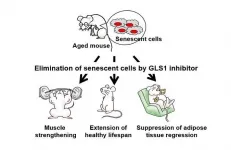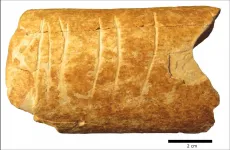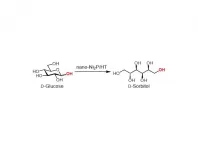Engineering immunity
Researchers use virus-like particles to craft a vaccine against malaria
2021-02-04
(Press-News.org) An inexpensive, long-lasting and easy-to-administer vaccine against malaria could be a game-changer for millions of people living in countries where the mosquito-borne disease is endemic.
Lucie Jelinkova, a graduate student in the laboratory of Bryce Chackerian, PhD, professor in The University of New Mexico Department of Molecular Genetics & Microbiology, has identified a method that could make that dream into reality.
In research recently published in the journal NPJ Vaccines, Jelinkova and colleagues at Johns Hopkins and Flinders University in Australia report that a vaccine based on virus-like particle (VLP) technology showed promise in generating antibodies to prevent the infection.
Their target was Plasmodium falciparum, a parasite that causes a severe form of malaria. It is injected into a host's blood stream by the Anopheles mosquito and rapidly moves to the liver, where it eventually infects red blood cells.
"The idea is to catch it before it infects the liver cells," Jelinkova says. "It bursts out of the liver cells into the blood. The goal is to stop it from getting to the point where it can reach the liver cells."
Existing vaccines either have limited effectiveness or require storage at ultra-cold temperatures, making them impractical for rural and impoverished parts of the world. VLP-based vaccines, the longtime focus of Chackerian's lab, represent a different approach.
VLPs are essentially viruses that have had most of their genetic material removed, rendering them harmless. The process leaves intact their outer protein coat, which stimulates the immune system to produce antibodies. Chackerian has developed a method for attaching sections of microbial proteins to the VLPs that induce protective antibodies.
In the current study, Jelinkova focused on circumsporozoite protein (better known as CSP), which sits on the surface of the parasite and plays a role in helping it to invade the host's liver cells, and is the target of an existing vaccine.
She turned to monoclonal antibodies isolated from human volunteers who had been immunized with another experimental vaccine. These antibodies bind to a particularly vulnerable region of the CSP molecule and protect against liver invasion in mouse models of malaria infection.
"That's where the VLP comes in," Jelinkova says. "We can take that one little site and decorate the VLP with it and elicit the response that would mimic the action of the monoclonals."
VLPs are inexpensive and typically very stable - and they don't require expensive refrigeration, Jelinkova says. They also produce durable immunity, whereas other types of vaccines require periodic boosters.
Jelinkova tested the VLP-based vaccine on mice who had been infected with a cousin of the falciparum parasite and found about 60 percent of the parasites were inhibited. Then, she added an adjuvant - a substance that enhances the effects of a vaccine - and found its effectiveness had grown to more than 90 percent, mimicking the effects of the monoclonal antibodies.
"Ninety percent is great, but it's not sterilizing immunity," she says. "We want to find ways to increase the antibody response." Going forward, she hopes to modify the VLP-based vaccine to recognize neighboring targets on the CSP molecule in hopes of enhancing its protective effects.
"We think we've developed a vaccine that not only targets an Achilles heel of the malaria parasite," Chackerian said, "but it also could be broadly applicable to the regions of the world that most desperately need a malaria vaccine."
INFORMATION:
ELSE PRESS RELEASES FROM THIS DATE:
2021-02-04
Tuberous sclerosis complex (TSC) afflicts as many as two million people around the world, affecting multiple organs, including lungs, brain, skin and kidneys. In about 80 percent of cases, it causes cysts and benign tumors to form in the kidney, eventually resulting in kidney failure.
It's known that the disease is triggered by genetic mutations, but how these mutations lead to the formation of kidney cysts has been poorly understood - until now.
Nephrologist Manoocher Soleimani, MD, a professor in The University of New Mexico Department of Internal Medicine, led a team that solved the puzzle and pointed the way toward potential ...
2021-02-04
Twitter has long provided a short, sharp take on the community's fears, anxieties and experiences. Now, data scientists have analysed 94 million tweets from the first months of the pandemic to track COVID-19's effect on mental health in NSW.
The research team used machine learning to develop a model able to capture data indicating depression, stress, anxiety and suicidal thoughts among users of the social media platform.
The aim was to tap into popular technology to help public health experts identify changes in community levels of depression over time.
The World Health Organisation highlighted early in 2020 that the pandemic would likely have a negative impact on mental health, with the disease affecting many facets of life including work, health and relationships.
Researchers from ...
2021-02-04
Senescent cells accumulate in organs during aging, promote tissue dysfunction, and cause numerous aging-related diseases like cancer. The cells arise through a process called "cellular senescence," a permanent cell cycle arrest resulting from multiple stresses.
A collaborative research group led by Professor Makoto Nakanishi of the Institute of Medical Science, The University of Tokyo (IMSUT), and co-researchers has identified an inhibitor of the glutamate metabolic enzyme GLS1(*1) so that its administration selectively eliminates senescent cells in vivo. They confirmed that the GLS1 inhibitor eliminated senescent cells from various organs and tissues in aged mice, ameliorating age-associated tissue dysfunction and the symptoms of obese diabetes, arteriosclerosis, and ...
2021-02-04
While scientists and historians have long surmised that etchings on stones and bones have been used as a form of symbolism dating back as early as the Middle Paleolithic period (250,000-45,000 BCE), findings to support that theory are extremely rare.
A recent discovery by archeologists from the Hebrew University and the University of Haifa alongside a team from the Le Centre National de la Recherche Scientifique in France have uncovered evidence of what may be the earliest-known use of symbols. The symbols were found on a bone fragment in the Ramle region in central ...
2021-02-04
A City of Hope-led research team found that the same gene that increases the risk for Alzheimer's disease, ApoE4, can increase the susceptibility to and severity of COVID-19.
"Our study provides a causal link between the Alzheimer's disease risk factor ApoE4 and COVID-19 and explains why some (e.g., ApoE4 carriers) but not all COVID-19 patients exhibit neurological manifestations" said Yanhong Shi, Ph.D., director of the Division of Stem Cell Biology at City of Hope and co-corresponding author of the new study. "Understanding how risk factors for neurodegenerative diseases ...
2021-02-04
The distinctive gut microbiome profile of a person with liver cancer linked to non-alcoholic fatty liver disease (NAFLD) could be the key to predicting someone's risk of developing the cancer, say researchers from the UNSW Microbiome Research Centre (MRC).
Their new study, published in Nature Communications recently, found the gut microbiome - the kingdom of microorganisms living in our digestive tracts - can modulate the immune response in liver cancer patients with NAFLD, in a way that promotes the cancer's survival.
While the research is still in its early stages, this finding could lead to more effective preventative and therapeutic treatments for people at risk of developing NAFLD-related liver ...
2021-02-04
The intestine harbors the largest number of immune cells in our body. Since the intestine is constantly exposed to various antigens like bacteria and food, appropriate induction of gut immune cells plays a pivotal role in gut homeostasis.
A POSTECH research team - led by Professor Seung-Woo Lee, Ph.D. candidate Sookjin Moon and research assistant professor Yunji Park of the Department of Life Sciences - has uncovered for the first the mechanism for regulating the differentiation of T cells (intraepithelial lymphocyte, IEL) via intestinal epithelial cells (IEC). These findings were recently published in the Journal of Experimental Medicine ...
2021-02-04
Cells replicate their genetic material and divide into two identical clones, perpetuating life -- until they don't. Some cells pause -- or are intentionally made to pause -- in the process. When the cell resumes division after such a pause, a displaced nucleus -- an essential part of cell survival -- can become caught in the fissure, splitting violently and killing both cells. But that is not always the case; some mutant cells can recover by pushing their nucleus to safety. Researchers from Hiroshima University in Japan are starting to understand how in the first step toward potential cell death rescue applications.
The results were published on Jan. 22 in iScience, a Cell Press journal.
The researchers examined fission yeast, a common model organism ...
2021-02-04
This is the finding of an 18-year-study of over 300,000 people with diabetes in England, from scientists from Imperial College London and published in the journal The Lancet Diabetes & Endocrinology.
Thursday Feb 4th is World Cancer Day.
The research, funded by the Wellcome Trust, reveals that between 2001-2018 heart disease and stroke were no longer the leading causes of death among people with diabetes, as they were 18 years ago.
Diabetes affects 4.7 million people in the UK, and is caused by the body being unable to regulate blood sugar levels. Around 90 per cent have type ...
2021-02-04
Osaka - Many different catalysts that promote the conversion of glucose to sorbitol have been studied; however, most offer certain properties while requiring compromises on others. Now, researchers from Osaka University have reported a hydrotalcite-supported nickel phosphide nanoparticle catalyst (nano-Ni2P/HT) that ticks all the boxes. Their findings are published in Green Chemistry.
Sorbitol is a versatile molecule that is widely used in the food, cosmetics, and pharmaceuticals industries. There is therefore a pressing need to produce sorbitol in a sustainable, low-cost, and green manner.
The nickel catalysts that are commonly used in the industrial hydrogenation of glucose to sorbitol are unstable in air and require hash reaction conditions. Rare metal alternatives--despite being ...
LAST 30 PRESS RELEASES:
[Press-News.org] Engineering immunity
Researchers use virus-like particles to craft a vaccine against malaria




